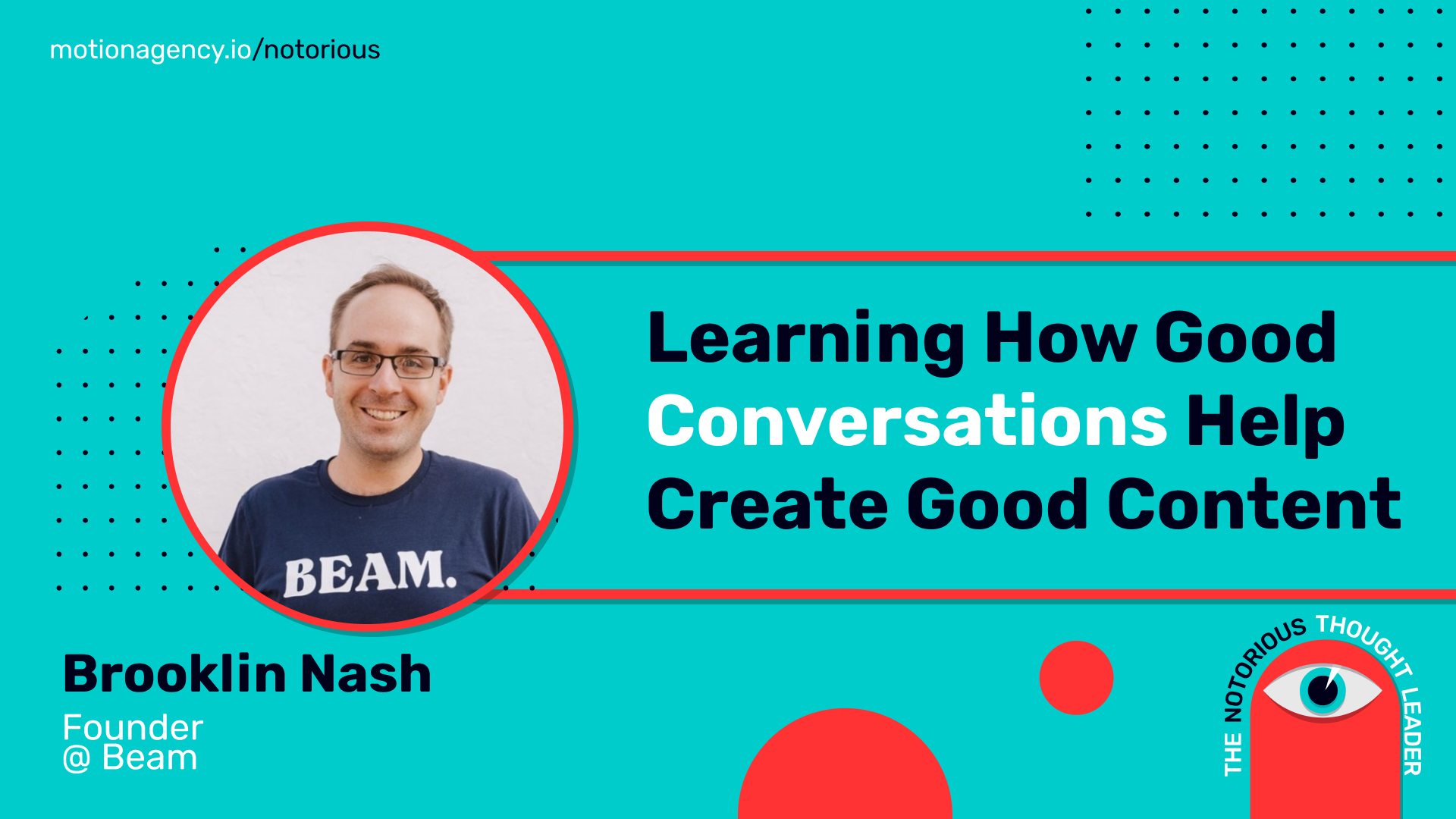Episode Summary
A content creator is someone who creates entertaining or educational material that is expressed through a medium or channel. And professional content creators go beyond creating and publishing digital content and use that content to build an audience and generate revenue.
However, sometimes, especially with B2B content, you have too much to create, and so your editorial planning is unfocused and hurried. This leads to generic, uninformed, and uninspired content, and your efforts do not lead to conversions or revenue.
In this episode of Notorious Thought Leader, our host Erin Balsa welcomes Brooklin Nash, the co-founder of Beam, a content creation agency. Brooklin explains how Beam can keep your B2B content interesting and help you sell. Brooklin and Erin discuss thought leadership, creating good content, and what can help you shape your messaging.
Guest Profile

- Name: Brooklin Nash
- What Brooklin does: Brooklin is the co-founder of Beam.
- Company: Beam
- Noteworthy: With a decade of freelance and in-house marketing experience, Brooklin has mastered the art of clear and simple client communication. About a year ago, Brooklin and his wife Becca decided to go the agency route and officially launched Beam last June. Brooklin focuses on helping both clients and freelancers stand out. In addition, as a guest contributor, Brooklin's written for G2, Drift, and MarketingProfs.
Key Insights
- What is thought leadership? Everyone interprets and describes thought leadership differently. According to Brooklin, if you build in public, talk about your experience, and share stories on social media, that's not thought leadership. As he says, you have to go deep into tactical and strategic elements to become a thought leader. "If you're truly taking the time to create content — either on your personal profiles and site or as a brand and through your team — to educate whatever category you're selling into, I think that is true thought leadership."
- Good content starts with good conversations. Brooklin, Becca, and Sam started Beam with two goals: to create better B2B content for their clients and a better experience for their freelancers. They believe great content starts with experts, not content marketers, and that good content starts with good conversations. Brooklin points out that they rely on experts and internal SMEs and CTOs, CPOs, CEOs, and CMOs to create excellent content. "We'll talk to everyone from an AE to the CEO internally, depending on the topic; external experts love that, too. You can tap your customers for content; it doesn't always have to be a case study. You can talk to them about what they're working on, what they've seen shift; you have that built-in network. You can lean on partners for the same, especially if you have platform partners and integration partners. And then, you can just reach out. If you're selling into RevOps, reach out to 25 RevOps pros who aren't connected to your company at all, aren't necessarily prospects, but probably have a lot to say on RevOps, and then you feature them in the content."
- A content professional adds value to content. If you work as a content creator, you are often hired by a company where different teams have different needs. Namely, people from sales want one thing, while those from marketing want something else, and it is the content creator’s job to understand the problem, find the gaps, and come up with a solution. Brooklin points out that he has that experience. "That's what's been a lot of fun in what we're doing for clients — being that person or team that comes in. And weirdly, even though we're coming from the outside, helping our clients connect the dots between product and sales and marketing. Because we'll get onboarded by the marketing team, and they'll say, 'These are some of the themes we're thinking through.' And then we'll get on with the sales team, and one of those four themes, they're like, 'We never hear about that; that doesn't seem relevant to the folks we're talking to.' So then we nix that."

Episode Highlights
Creating a Category vs. Selling Into an Existing Category
“If you’re creating a category, it starts more organically, and I don’t mean search; I mean those partnerships and conversations and social posts that need to happen before you start creating long-form guides and deep-dive articles and things like that. Just take the time to talk to others in your space, engage with folks on social, and look for those organic opportunities to validate your message. Dig deeper into what people are talking about, what people want to know about, and then that would inform what you create moving forward.
If you’re selling into an existing category, it’s more about not taking a contrary stance but trying to get into the elements of the category that folks don’t often cover because they’re still up here at the 5,000-foot level.”
Starting Beam
“What Becca — my wife — and I kept coming back to is, ‘We’ve been writing for nearly nine years. We know how to do it well, it’s still enjoyable to us, but are we learning anything new by creating the same content for clients?’ So we wanted to shift two things. One, we wanted to shift the focus of what content we create for clients, which is part of the rebrand and the launch in June. And honestly, we wanted to learn new things that we hadn’t done before. We wanted to learn what it looks like to build a project management system, what it looks like to bring on new hires and build a team and create a ‘company culture,’ which sounds a little silly because there are four of us right now, but soon to be five. But that part has been a lot of fun and learning all the things that we hadn’t done before because we had been all in on content production.”
Most B2B Content Is Boring
“There’s an issue with SEO articles on supposedly a specific topic starting at the broadest possible level. You’re looking at how to change the carburetor in your Ford, and it’s starting with ‘What is an automobile?’ — like the B2B equivalent of that often. And that’s not to say lots of folks don’t do SEO well; it leads to the lowest common denominator where the number one goal is to rank on the first page. But I started looking into it, and often, even if you’re on the first page and getting traffic, bounce rates can be really high, the conversion rate can be really low, and you’re not actually seeing all that much ROI from that type of content.
So, what we wanted to do was fill that middle of the funnel — that education phase — where, okay, people land on your site from LinkedIn or from organic search or a paid ad or whatever; what’s the next step to educate them in the buying process? And B2B content can be boring because brands will skip that step. They’ll go from organic or paid or whatever the channel is to the CTA and driving them into the sales conversations rather than recognizing the need to fill that education gap in the middle and what input you need to do that.”
Interviewing External SMEs Helps Shape Your Messaging
“Even internally, if you’re dealing with a large enough company. That’s why we started doing a month of onboarding, where we interview at least five or six people internally, and ideally as spread out across the company as possible. So we’ll talk to an AE about what their sales conversations look like; we’ll talk to the CTL about their product, the whole gamut, to get all these perspectives. You probably wouldn’t be surprised at how often discrepancies come up in those calls.
This was a while ago, but we were onboarding the client, and we were talking to the two co-founders — one was a technical co-founder and the CTO, and one was the CEO. And we were on separate calls with them, and they were saying two completely different things about the same topic. So then, in a follow-up, I was like, ‘What are we going with here because you’re saying different things? We need to land on what the narrative is and what makes sense.’ So that comes up a lot more often than maybe a lot of marketers would expect.”

